The holiday shopping season is officially upon us, and marketing efforts coinciding with this time of year are sure to include influencers. With so many opportunities for sharing gift ideas and party tips, the holidays and social content creators are an ideal match. How could your holiday influencer campaign be anything less than a smashing success?
Not so fast.
As influencer marketing has grown in popularity – according to eMarketer, 71% of marketers will have increased or maintained their influencer marketing budgets this year – the landscape of social platforms, creators and user-generated content campaigns has become increasingly competitive and complex. Brands will need to get a little more strategic if they want their influencer marketing to stand out in the holiday rush.
Earlier this year, CreatorIQ analyzed data of more than 1,000 influencer campaigns that ran on our platform since 2014. We uncovered some key influencer marketing trends that brands should be thinking about as they team up with content creators during the 2017 holidays and beyond.
Engage Brand Ambassadors
While big celebrity influencers certainly have their place, many brands are finding that it’s equally, and in some cases, more valuable to build relationships with creators who have smaller, but highly loyal and more targeted followers. According to the research, the average number of influencers per campaign has increased by a whopping 350 percent since 2014.
For example, Ipsy’s Open Studios program is a good case study of how the beauty sample subscriber enabled thousands of beauty creators to help build a brand. These influencers are not high-profile celebrities, but they have highly engaged followers who are very interested in learning about beauty products. Overall, brand ambassador programs are a great way to leverage a large number of influencers who are authentically enthusiastic about your product. Specifically, last year Starbucks held a Red Cup Contest to invite people to join in the creation of its annual holiday cup, which transformed an army of customers into ambassadors for its brand.
Create a Story
To amplify their message, brands also need to think about how they can work with creators to build stories that can be used across multiple touch points and social platforms, increasing the chances they won’t get lost in the holiday clutter. A recent successful example of this approach is Casey Neistat’s 2016 holiday collaboration with Samsung on a human flying drone, which resulted in a mini-movie, a “making-of” video, Instagram posts and more. There’s also evidence that supports the growing popularity of storytelling campaigns, which shows a 300 percent increase in the number of social posts per campaign since 2014. In this landscape, “one-and-done” posts are not going to have much of an impact.
Out with the Old (Spreadsheets)
As the pace and scope of influencer marketing increases, brands are finding it more challenging to manage and measure their campaigns at scale. At the same time, marketing departments are increasingly under pressure to provide validation that their influencer investments are generating maximum earned media value (EMV). Excel spreadsheets are no longer a realistic or efficient way to keep track of multiple influencer relationships across multiple platforms. Brands should consider deploying technology that can help them discover influencers, manage campaigns, relationships and track performance.
Just like other marketing approaches that have come before it, influencer marketing is evolving rapidly. Brands need to keep up with key trends to realize a return on their investments, especially during the all-important holiday shopping season.
Tim Sovay is COO of CreatorIQ

